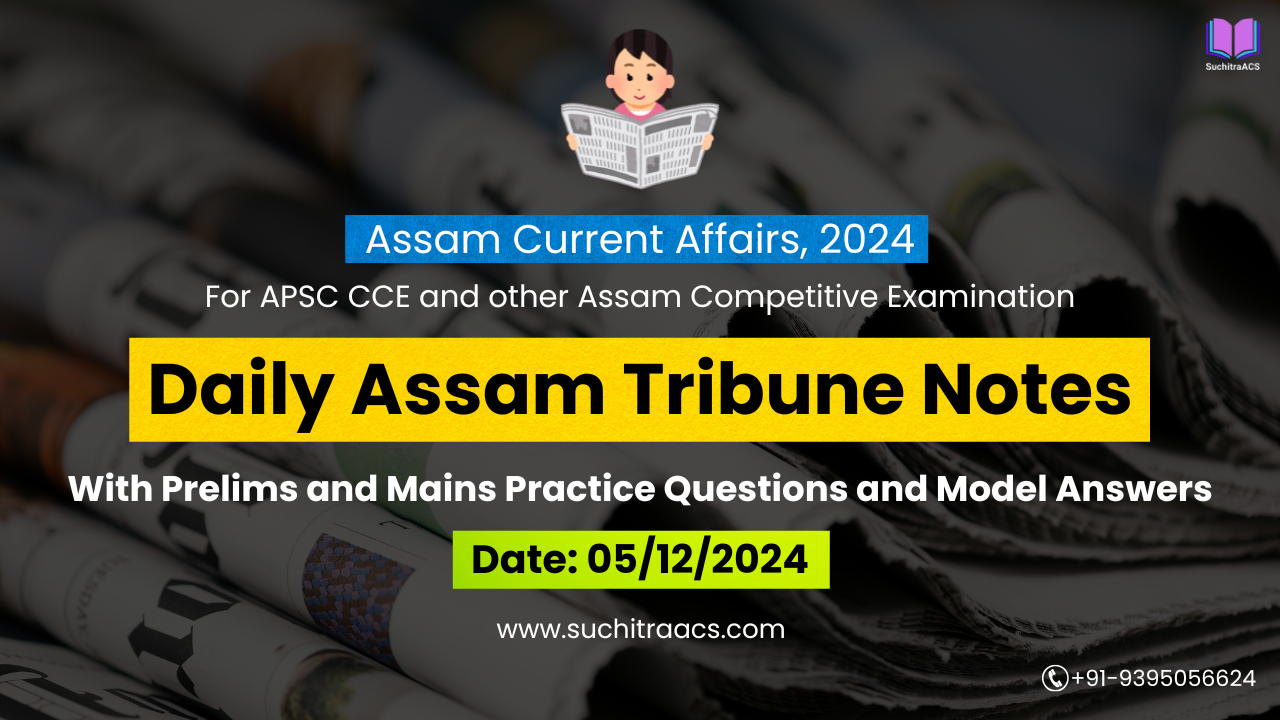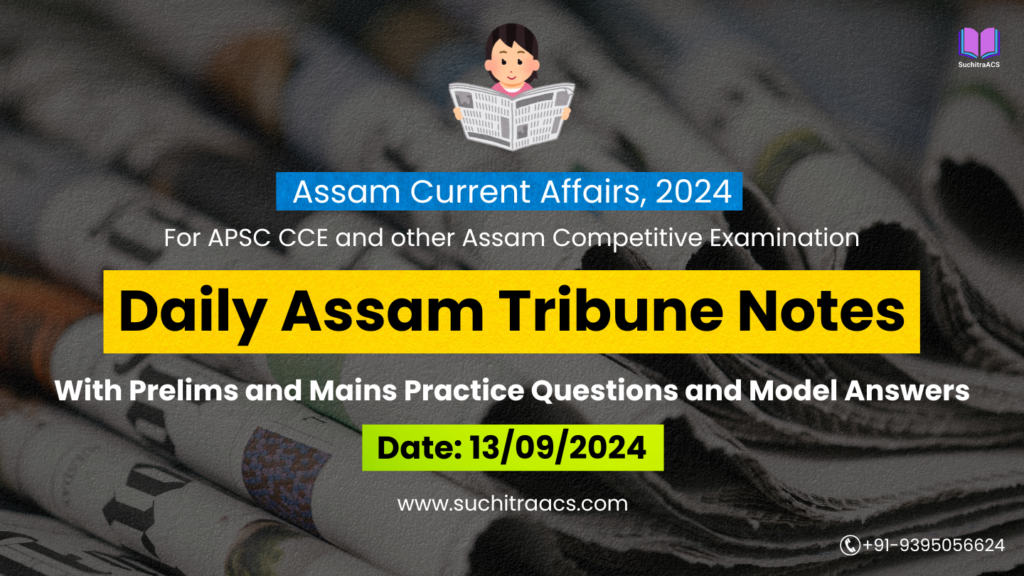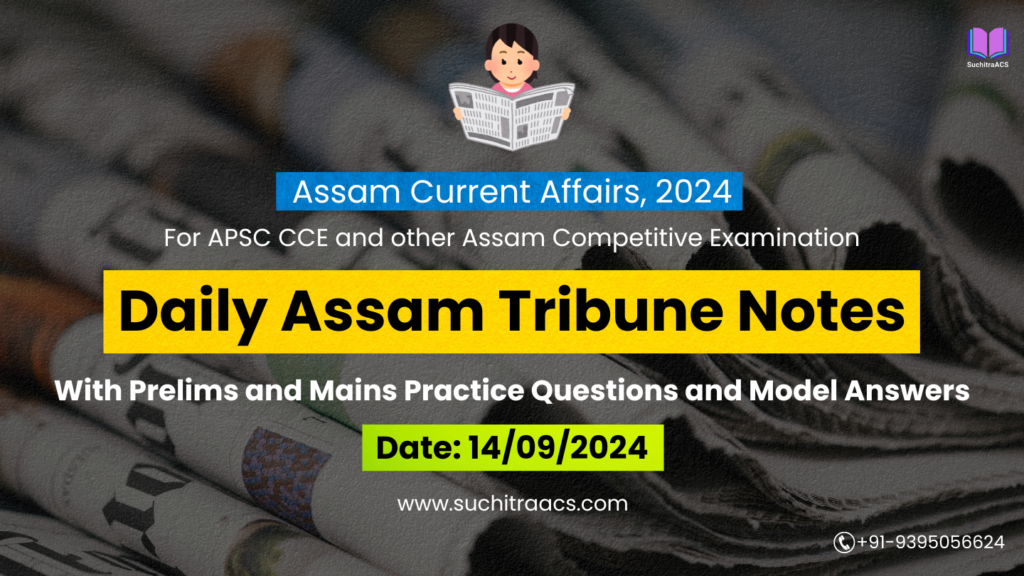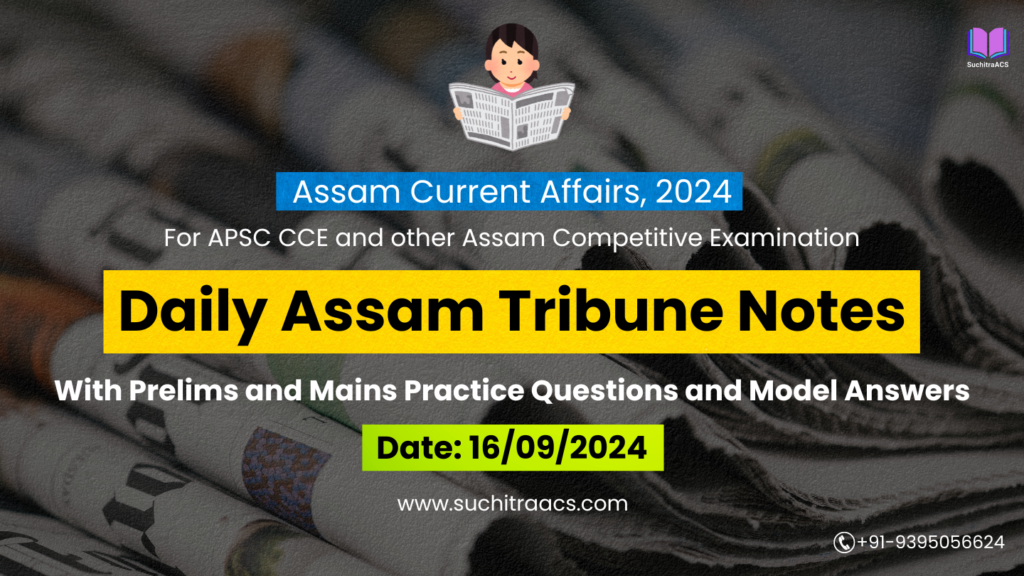APSC Current Affairs: Assam Tribune Notes with MCQs and Answer Writing (05/12/2024)
For APSC CCE and other Assam Competitive examinations aspirants, staying updated with current affairs is vital. This blog covers most important topics from the Assam Tribune today (05-12-2024). These issues are key for both APSC Prelims and Mains preparation, offering insights into the APSC CCE Syllabus.
1. Skill Development Through ITIs in Assam
Relevant for: GS Paper 3 – Economy, Human Resource Development
Introduction
The Assam government has announced plans to establish 70 new Industrial Training Institutes (ITIs) in “unserved” Legislative Assembly Constituencies (LACs). This initiative aims to revolutionize the skill development landscape in the state by integrating industry participation.
Key Facts
- Target Area: New ITIs to be established in every LAC, with future expansion planned to each block.
- Collaboration: Partnerships with organizations such as TATA Technologies, Honda CSR, and Festo.
- Investment: Support from both state and central governments.
- Technology Inclusion: Integration of advanced facilities like Centers of Excellence.
Importance
- Economic Growth: Creates a skilled workforce to drive industrial growth.
- Youth Empowerment: Reduces unemployment by providing employable skills.
- Industry Linkage: Tailors training programs to meet industry needs.
- Regional Development: Positions Assam as a hub for ASEAN-related industries.
Challenges
- Infrastructure Gaps: Delays in construction and operational readiness.
- Skill Mismatch: Difficulty aligning curriculum with rapidly evolving industry needs.
- Rural Outreach: Ensuring participation from underprivileged and rural youth.
- Funding Sustainability: Dependence on long-term public and private investments.
Way Ahead
- Industry Engagement: Encourage industries to adopt ITIs and co-design courses.
- Monitoring Mechanisms: Regularly assess ITI outcomes for relevance and impact.
- Digital Inclusion: Use e-learning platforms to expand accessibility.
- Skill Innovation: Promote entrepreneurship through specialized training modules.
Conclusion
The establishment of ITIs represents a transformative step for Assam’s economy and human resource development. By fostering industry partnerships and inclusive growth, the state can create a resilient skill ecosystem.
2. E-Kaksha: Assam’s Digital Learning Initiative
Relevant for: GS Paper 2 – Governance, Education
Introduction
Samagra Shiksha, Assam, in collaboration with Mission Gyan, has launched the e-Kaksha platform, a digital education initiative aimed at providing free, high-quality learning content for students across Assam.
Key Features
- Subject Coverage: English, Assamese, Geography, History, and Social Science for Classes 1–10.
- Language Inclusion: Content delivered in Assamese, with plans to expand to Bengali and Bodo mediums.
- Accessibility: Over 1,000 video lessons available on YouTube and Mission Gyan App.
- Teacher Recognition: Certificates awarded to 45 teachers for developing e-content.
Significance
- Bridging Teacher Shortages: Addresses lack of subject-specific teachers in rural areas.
- Equity in Education: Ensures access to quality education for marginalized groups.
- Digital Literacy: Enhances students’ exposure to modern learning tools.
- Localized Content: Promotes effective learning by using regional languages.
Challenges
- Digital Divide: Limited access to devices and internet in remote areas.
- Content Expansion: Need for broader subject coverage and multi-language support.
- Teacher Training: Capacity building for teachers to create effective e-content.
- Sustainability: Continuous funding required for platform maintenance and content development.
Way Ahead
- Community Involvement: Encourage local stakeholders to promote the platform.
- Infrastructure Enhancement: Expand digital connectivity in rural areas.
- Resource Integration: Collaborate with NGOs for supplementary educational materials.
- Impact Assessment: Monitor and improve platform efficiency based on user feedback.
Conclusion
The e-Kaksha initiative exemplifies how technology can bridge educational disparities. By fostering inclusivity and innovation, Assam can set a benchmark in digital learning for other states.
3. Development of Assam State Disaster Management Infrastructure
Relevant for: GS Paper 3 – Disaster Management
Introduction: The Assam State Disaster Management Authority (ASDMA) has initiated new projects aimed at enhancing flood and disaster resilience. Efforts include establishing advanced flood shelters and improved disaster response systems.
Key Facts:
- New Flood Shelters: Designed to withstand multi-day flooding and equipped with essential amenities.
- Collaboration: Partnerships with international organizations for funding and technical expertise.
- Digital Mapping: Deployment of advanced Geographic Information Systems (GIS) for real-time flood mapping.
Prelims Pointers:
- GIS Mapping: Technology used for disaster prediction and management.
- Flood Shelters: Temporary facilities designed for safety during emergencies.
- ASDMA: A state-level disaster management body.
Mains Pointers:
- Importance:
- Disaster Preparedness: Reduces loss of life and property during floods.
- Climate Resilience: Helps communities adapt to frequent natural disasters.
- Economic Impact: Reduces rehabilitation costs.
- Challenges:
- Implementation Delays: Difficulty in acquiring land for shelters.
- Funding: Limited state resources for large-scale infrastructure projects.
- Community Participation: Need for increased awareness and involvement.
Way Forward:
- Establish a robust monitoring mechanism for project timelines.
- Increase public awareness about disaster preparedness.
- Leverage public-private partnerships to fund advanced infrastructure.
Conclusion:
Strengthening Assam’s disaster management infrastructure is essential for mitigating the region’s vulnerability to frequent natural disasters. By investing in advanced technology, fostering inter-agency coordination, and ensuring community participation, Assam can enhance its disaster resilience and safeguard lives, livelihoods, and ecosystems.
4. Assam Agricultural University’s Innovation in Sustainable Practices
Relevant for: GS Paper 3 – Agriculture and Environment
Introduction: Assam Agricultural University (AAU) showcased its innovative projects focusing on sustainability at a recent expo. These include zero-waste farming practices and eco-friendly product innovations.
Key Facts:
- Highlights:
- Aquaculture and hydroponics systems.
- Bamboo-based zero-waste processes.
- Eco-friendly agricultural practices like vermicomposting.
- Community Engagement: AAU works closely with over 10,000 farmers, promoting rural entrepreneurship through Kisan Fellows programs.
Prelims Pointers:
- Hydroponics: Soil-less farming technique using nutrient-rich solutions.
- Zero-Waste Farming: Maximizing efficiency in agricultural outputs.
- Kisan Fellows Program: An initiative to promote farmer leadership in sustainable practices.
Mains Pointers:
- Importance:
- Sustainability: Promotes eco-friendly farming practices.
- Skill Development: Trains farmers in advanced agricultural techniques.
- Economic Empowerment: Encourages rural entrepreneurship.
- Challenges:
- Resource Constraints: Limited funding for scaling innovations.
- Adoption Barriers: Resistance from traditional farmers to adopt new techniques.
- Market Access: Ensuring fair pricing for sustainable products.
Way Forward:
- Strengthen partnerships with NGOs for farmer training.
- Introduce policy incentives for adopting zero-waste practices.
- Promote market linkages for eco-friendly agricultural products.
Conclusion: Assam Agricultural University’s focus on sustainable practices highlights its leadership in addressing agricultural challenges through innovation. By expanding its initiatives and fostering farmer engagement, the university can play a pivotal role in driving ecological balance and ensuring food security for the region and beyond.
APSC Prelims Practice Questions
1. Skill Development Through ITIs in Assam
Question:
Which of the following statements about the ITI expansion program in Assam is/are correct?
- The initiative aims to establish Industrial Training Institutes (ITIs) in every Legislative Assembly Constituency (LAC) in Assam.
- The program is supported through collaborations with private companies such as TATA Technologies and Honda CSR.
- Advanced facilities like Centers of Excellence will be included in the new ITIs.
Select the correct answer using the code below:
A. 1 only
B. 2 and 3 only
C. 1, 2, and 3
D. 1 and 3 only
Answer: C
Explanation:
- Statement 1: Correct. The Assam government has announced plans to set up ITIs in all unserved Legislative Assembly Constituencies.
- Statement 2: Correct. Partnerships with private organizations like TATA Technologies, Honda CSR, and Festo have been confirmed.
- Statement 3: Correct. Centers of Excellence with advanced facilities are part of the program to improve skill training.
2. E-Kaksha: Assam’s Digital Learning Initiative
Question:
Which of the following features of Assam’s e-Kaksha initiative is/are correct?
- It provides free online learning resources for students in Classes 1–10.
- The initiative currently offers content in Assamese, Bengali, and Bodo languages.
- Over 1,000 video lessons are available through the Mission Gyan app.
Select the correct answer using the code below:
A. 1 and 2 only
B. 1 and 3 only
C. 1, 2, and 3
D. 2 and 3 only
Answer: B
Explanation:
- Statement 1: Correct. The e-Kaksha initiative offers free educational resources for students in Classes 1–10.
- Statement 2: Incorrect. Currently, content is available in Assamese, with plans to expand to Bengali and Bodo.
- Statement 3: Correct. Over 1,000 video lessons are hosted on YouTube and the Mission Gyan app.
3. Development of Assam State Disaster Management Infrastructure
Question:
What is the role of Geographic Information Systems (GIS) in Assam’s disaster management efforts?
A. Enhancing real-time flood mapping and prediction capabilities.
B. Building flood shelters in disaster-prone areas.
C. Monitoring deforestation to prevent landslides.
D. Conducting post-disaster economic impact assessments.
Answer: A
Explanation:
GIS technology is being deployed in Assam to enhance real-time flood mapping and improve disaster response systems. While related initiatives exist, options B, C, and D are not direct roles of GIS in this context.
4. Assam Agricultural University’s Innovation in Sustainable Practices
Question:
Which of the following practices is promoted by Assam Agricultural University to ensure sustainability in agriculture?
- Hydroponics for soil-less farming.
- Bamboo-based zero-waste processes.
- Genetic modification of crops to increase yield.
Select the correct answer using the code below:
A. 1 and 2 only
B. 1 only
C. 2 and 3 only
D. 1, 2, and 3
Answer: A
Explanation:
Statement 3: Incorrect. The university focuses on eco-friendly and sustainable methods rather than genetic modification.
Statement 1: Correct. Hydroponics is one of the sustainable agricultural practices promoted by the university.
Statement 2: Correct. Bamboo-based zero-waste processes are part of their innovative initiatives.
APSC Mains Practice Question
Topic: Brahmaputra River Drying During Lean Season
GS Paper 3: Environment, Disaster Management, and Geography
The Brahmaputra River’s drying during lean seasons presents significant socio-economic and environmental challenges for Northeast India. Discuss the causes of this phenomenon and its implications. Suggest measures to ensure sustainable management of the river system.
Model Answer
Introduction:
The Brahmaputra River, originating in Tibet as the Yarlung Tsangpo, is a lifeline for Northeast India. However, abnormal drying during lean seasons has raised concerns over the river’s sustainability. Factors such as reduced rainfall, sedimentation, and climate variability are exacerbating the issue, impacting agriculture, biodiversity, and regional livelihoods.
Causes of the Brahmaputra River Drying:
- Reduced Rainfall:
- A 20–30% decline in monsoon rainfall in Assam and Himalayan foothills over the last two decades.
- Sedimentation:
- Increased sediment deposition raises the riverbed, reducing water-carrying capacity.
- Erosion from deforestation and unregulated construction exacerbates sediment loads.
- Climate Change:
- Altered precipitation patterns and glacial melt cycles disrupt water flow.
- Cross-Border Dynamics:
- A significant portion of the Brahmaputra’s water originates in China, where upstream interventions may affect downstream flow.
- Human Activities:
- Over-extraction of water for irrigation, urbanization, and hydropower projects reduce downstream availability.
Implications of the Drying Brahmaputra:
- Agriculture and Livelihoods:
- Decreased water availability for irrigation impacts crop productivity, endangering food security.
- Biodiversity Loss:
- Aquatic ecosystems dependent on steady water flow are under threat.
- Increased Flood Vulnerability:
- Sediment accumulation worsens floods during monsoons, damaging infrastructure and displacing communities.
- Economic Impact:
- Declining water levels hinder navigation and hydropower projects, affecting trade and energy production.
- Geopolitical Tensions:
- Cross-border disputes over water sharing may escalate, affecting bilateral relations with China and Bangladesh.
Measures for Sustainable Management:
- Integrated Water Resource Management (IWRM):
- Develop a basin-wide approach, combining hydrological modeling with local water conservation practices.
- Sediment Control Measures:
- Afforestation in catchment areas and riverbank stabilization to reduce soil erosion.
- Large-scale dredging to restore water-carrying capacity.
- Climate-Resilient Infrastructure:
- Invest in infrastructure that adapts to fluctuating water levels, such as multipurpose dams with ecological safeguards.
- Strengthened Bilateral Agreements:
- Engage China and Bangladesh for transparent water-sharing agreements and joint climate adaptation projects.
- Community Engagement and Awareness:
- Educate local communities on sustainable water use and involve them in conservation initiatives.
- Research and Monitoring:
- Strengthen monitoring systems to study sedimentation, glacial melt, and water flow patterns.
Conclusion:
The drying of the Brahmaputra is a multifaceted challenge that requires coordinated efforts across environmental, technological, and geopolitical domains. Sustainable management of the river system can ensure ecological balance, economic stability, and regional cooperation, safeguarding the interests of the Northeast and the nation.
✨ APSC Prelims Crash Course, 2025
at most affordable rate in Assam!

🔔 Join Our WhatsApp Study Group!
For exclusive access to premium quality content, including study materials, current affairs, MCQs, and model answers for APSC CCE and other Assam competitive exams.
Click here to join: SuchitraACS Study WhatsApp Group
📚 Want to know more about SuchitraACS’s most affordable courses?
Click here to know more: SuchitraACS Courses for APSC CCE and Assam Competitive Examinations




